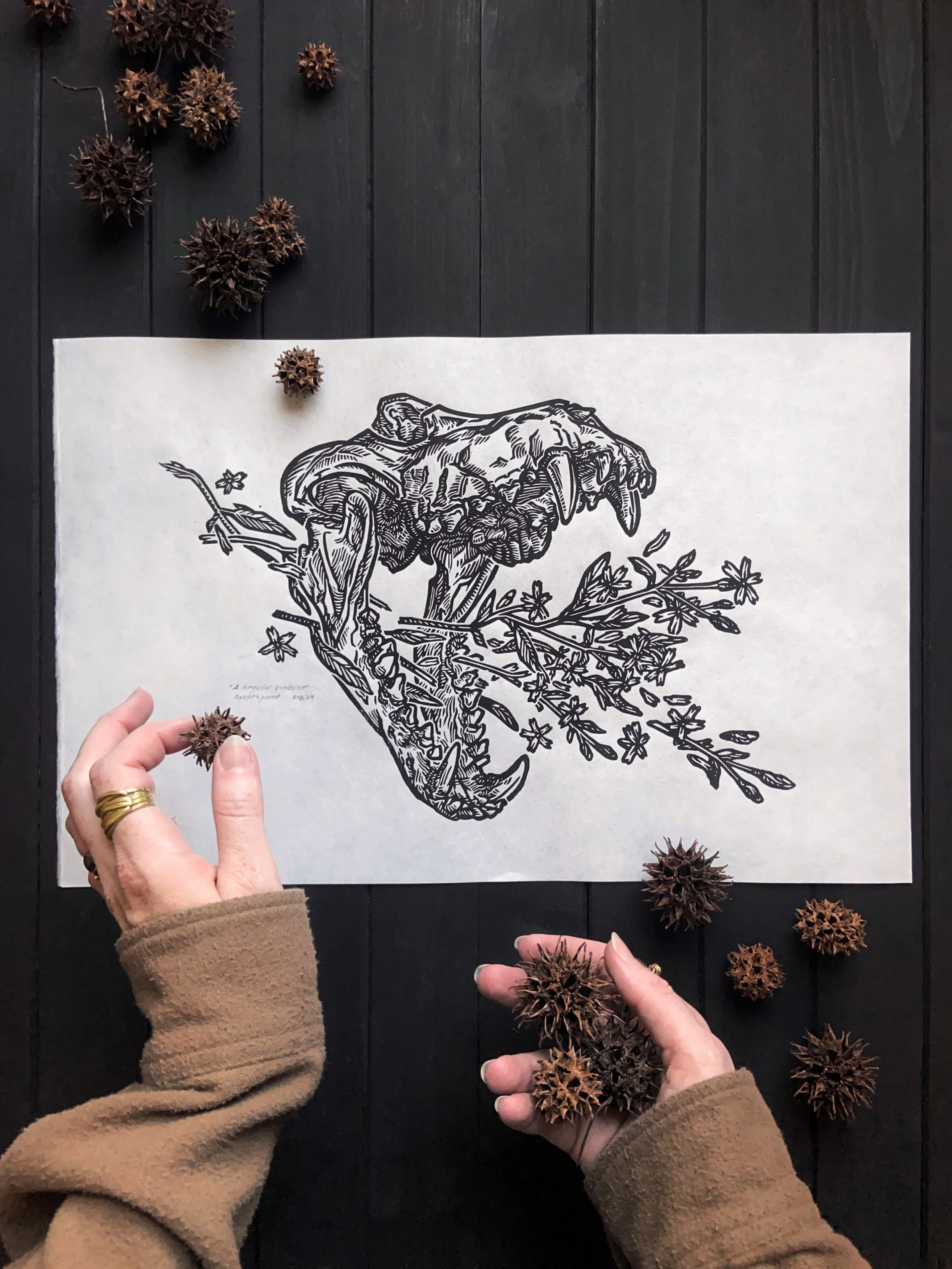The Old Growth Fine Art Print
The Old Growth: North American Megafauna Project, #4
Cervalces scotti and Virgin's Bower Vine
Named in honor of the branching antlers of the species starring in it, The Old Growth depicts the skull of Cervalces scotti, commonly referred to as the elk moose, entwined with Virgin’s Bower vines, a modern-day plant common to the Great Lakes Area. Once native to marshy or swampy areas within Canada and mostly northern United States, the elk moose did, indeed, almost look like a cross between these species. Its powerful body was similar in size and build to the modern-day moose, and up to eight feet long, while its head was more delicate and elk-like, with intricate and wide “palmate” antlers (meaning the areas between individual tines are more filled in).
Paleontologists are currently unsure if the elk-moose was hunted by early humans, and whether its extinction is due in part to that. What we do know, however, is many modern-day species in the Great Lakes region now are endangered due to human activity. Hunting, overfishing, development of wild areas, and pollution all have contributed to depleting the populations of species such as the Eastern Fox Snake, Golden-winged Warbler, and the Green Salamander. Ohio, a location where multiple Cervalces scotti remains have been found, was once far more biologically diverse than it is now, with estimates of up to 95% of the state having once been forested as little as two hundred years ago. Now only about 20% of these forests remain, having been taken over by lumber companies, farming, and other development.
Printed on uncoated acid-free paper with fade-resistant, archival inks. 11” x 17”
Handle gently to avoid damaging the velvety texture of this print, and frame using archival materials for longevity of display.
The Old Growth: North American Megafauna Project, #4
Cervalces scotti and Virgin's Bower Vine
Named in honor of the branching antlers of the species starring in it, The Old Growth depicts the skull of Cervalces scotti, commonly referred to as the elk moose, entwined with Virgin’s Bower vines, a modern-day plant common to the Great Lakes Area. Once native to marshy or swampy areas within Canada and mostly northern United States, the elk moose did, indeed, almost look like a cross between these species. Its powerful body was similar in size and build to the modern-day moose, and up to eight feet long, while its head was more delicate and elk-like, with intricate and wide “palmate” antlers (meaning the areas between individual tines are more filled in).
Paleontologists are currently unsure if the elk-moose was hunted by early humans, and whether its extinction is due in part to that. What we do know, however, is many modern-day species in the Great Lakes region now are endangered due to human activity. Hunting, overfishing, development of wild areas, and pollution all have contributed to depleting the populations of species such as the Eastern Fox Snake, Golden-winged Warbler, and the Green Salamander. Ohio, a location where multiple Cervalces scotti remains have been found, was once far more biologically diverse than it is now, with estimates of up to 95% of the state having once been forested as little as two hundred years ago. Now only about 20% of these forests remain, having been taken over by lumber companies, farming, and other development.
Printed on uncoated acid-free paper with fade-resistant, archival inks. 11” x 17”
Handle gently to avoid damaging the velvety texture of this print, and frame using archival materials for longevity of display.
The Old Growth: North American Megafauna Project, #4
Cervalces scotti and Virgin's Bower Vine
Named in honor of the branching antlers of the species starring in it, The Old Growth depicts the skull of Cervalces scotti, commonly referred to as the elk moose, entwined with Virgin’s Bower vines, a modern-day plant common to the Great Lakes Area. Once native to marshy or swampy areas within Canada and mostly northern United States, the elk moose did, indeed, almost look like a cross between these species. Its powerful body was similar in size and build to the modern-day moose, and up to eight feet long, while its head was more delicate and elk-like, with intricate and wide “palmate” antlers (meaning the areas between individual tines are more filled in).
Paleontologists are currently unsure if the elk-moose was hunted by early humans, and whether its extinction is due in part to that. What we do know, however, is many modern-day species in the Great Lakes region now are endangered due to human activity. Hunting, overfishing, development of wild areas, and pollution all have contributed to depleting the populations of species such as the Eastern Fox Snake, Golden-winged Warbler, and the Green Salamander. Ohio, a location where multiple Cervalces scotti remains have been found, was once far more biologically diverse than it is now, with estimates of up to 95% of the state having once been forested as little as two hundred years ago. Now only about 20% of these forests remain, having been taken over by lumber companies, farming, and other development.
Printed on uncoated acid-free paper with fade-resistant, archival inks. 11” x 17”
Handle gently to avoid damaging the velvety texture of this print, and frame using archival materials for longevity of display.









